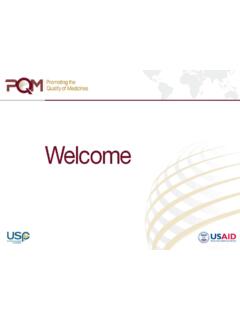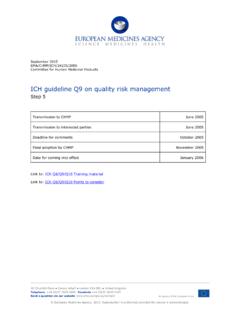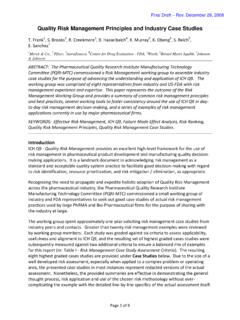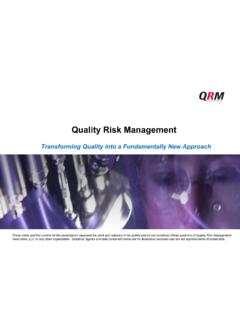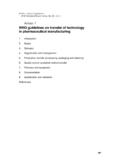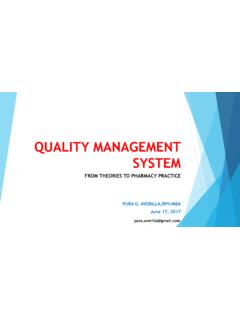Transcription of CLEANING VALIDATION WITH RISK ASSESSMENT
1 2016. ALL RIGHTS RESERVED. CLEANING VALIDATION with RISK ASSESSMENT Bangkok, Thailand July 26 2017 Jairaj (Jai) Mehta, Consultant, Promoting the quality of Medicines CLEANING VALIDATION with Risk ASSESSMENT Presentation Outline: Regulatory History and Guidelines Evolution of CLEANING VALIDATION and Risk ASSESSMENT US FDA Guide to Inspection of VALIDATION of CLEANING Processes (1993) US FDA Draft Guidance for Manufacturing, Processing, or Holding Active pharmaceutical Ingredients (1998) APIC Guide CLEANING VALIDATION in Active pharmaceutical Ingredient Manufacturing Plants (1999) & Companion Document Guidance on Aspects of CLEANING VALIDATION in Active pharmaceutical Ingredient Plants (2000) ICH Q7A Guidance for Good Manufacturing Practice Guidance for Active pharmaceutical Ingredients (2001) and ICH Q7 Revision 1 (2016) ICH Q9 quality Risk management (2006) ISPE Baseline Guide for The Risk-Based Manufacture of pharmaceutical Products (Risk-MaPP) (2009)
2 EMA Guideline on Setting Health Based Exposure Limits For Use in Risk Identification in The Manufacture of Different Medicinal Products in Shared Facilities (2014) CLEANING VALIDATION How to Conduct with Risk ASSESSMENT Principles Regulatory History and Guidelines Evolution of CLEANING VALIDATION and Risk ASSESSMENT US FDA Guide to Inspection of VALIDATION of CLEANING Processes (1993) - The Guide Cites .. 21 CFR Equipment CLEANING and Maintenance Regulation. Cholesteramine Resin Recall, Related To Contamination By Tainted Recovered Solvent Drums Used From Pesticide Facility In 1988 Incident in 1992, Foreign BPC (API) Manufacturer Produced Potent Steroids with Did Not Perform Adequate CLEANING for Related - Leading To Contamination .. Requires Written Procedures and Definition Of Acceptable Level of Clean Regulatory History and Guidelines Evolution of CLEANING VALIDATION and Risk ASSESSMENT US FDA Guide to Inspection of VALIDATION of CLEANING Processes (1993) - The Guide Cites.
3 Continued Prevent Drying On Of Residues on Dirty Analytical Method Should be Validated to Evaluate % Recovery of API .. Sampling Methods - Swabbing Preferred from Hardest To Clean Accessible Areas and Dried On Residues - Rinse Method Provides Advantage Of Reaching Inaccessible Areas Refers to General Industry Approach 1 of Cleanliness Limits Suggested @10 ppm or 1/1000 Of Therapeutic Dose. _____ 1- Apparent Reference to Fourman, G., and Mullin, M. , "Determining CLEANING VALIDATION Acceptance Limits for pharmaceutical Manufacturing Operations," pharmaceutical Technology, April, 1993. Regulatory History and Guidelines Evolution of CLEANING VALIDATION and Risk ASSESSMENT US FDA Draft Guidance for Manufacturing, Processing, or Holding Active pharmaceutical Ingredients (1998) 21 CFR Parts 210 & 211 Do Not Apply To API s - FDA Decided To Issue The Regulations As a Guidance Document Dedicated Facility, Separate Air Handling & Dedicated Equipment, like for Penicillins, May Be Necessary for Cytotoxic & Other Hazardous Substances which Show Sensitization At Extremely Low Levels.
4 Matrix Approach Okay for Product Selection for CLEANING VALIDATION - Use Of Worst-Case API Based on Potency, Toxicity, Solubility, and Difficulty Of CLEANING Regulatory History and Guidelines Evolution of CLEANING VALIDATION and Risk ASSESSMENT US FDA Draft Guidance for Manufacturing, Processing, or Holding Active pharmaceutical Ingredients (1998) Sampling was recommended to Include Swabbing, Rinsing, or Alternative methods Residue Limits were Recommended to be Practical, Achievable, Verifiable, and Based on the Most Deleterious Residue, Based on Pharmacological or Physiological activity of the API. No Reference to Historical 10 ppm or 1/1000th of Dose Carryover Limit Left it Up To the Industry to Justify Actual Limits. US FDA Deferred to ICH Q7 Guidance, and Left Its Own Guidance as a Draft.
5 Regulatory History and Guidelines Evolution of CLEANING VALIDATION and Risk ASSESSMENT APIC (A Sector Group of CEFIC) Guide CLEANING VALIDATION in Active pharmaceutical Ingredient Manufacturing Plants (1999) & Companion Document Guidance on Aspects of CLEANING VALIDATION in Active pharmaceutical Ingredient Plants (2000) Defined CLEANING VALIDATION (CV) for APIs as The Process of Providing Documented Evidence That the CLEANING Methods Employed Within a Facility Consistently Controls Potential Carryover of Product (Including Intermediates and Impurities), CLEANING Agents and Extraneous Material Into Subsequent Product To a Level Which is Below Predetermined Levels. CV Limit -1/1000th Therapeutic Daily Dose (TDD) of Previous Material Into the Next Product Batch TDD.
6 Maximum Allowable Carryover (MACO) Limit- TDD previous x MBS MACO = ------------------------------------- SF x TDD next SF Safety Factor Normally for Oral Dosage is 100 to 1,000 Topicals is 10 to 100 Parenterals is 1,000 to 10,0000 MBS Minimum Batch Size of the Next Product Regulatory History and Guidelines Evolution of CLEANING VALIDATION and Risk ASSESSMENT APIC Guide Continued When No TDD Available, CV MACO Limit Based on Toxicity Data by Calculating the NOEL (No Observable Effect Level) Value LD50 (g/kg) x 70 (kg person) NOEL = ---------------------------------------- ------------ 2,000 (an Empirical Constant) NOEL x MBS MACO = ------------------------------------- SF x TDD next When the Above Methods Result in Unacceptably High The Approach of a General Limit May be Suitable, such as 10 ppm Carry Over in the Next Product Batch.
7 The Surface Samples Swab Limit = MACO/Total Surface Area in Contact with Product in Equipment Train. Regulatory History and Guidelines Evolution of CLEANING VALIDATION and Risk ASSESSMENT ICH Q7A Guidance for Good Manufacturing Practice Guidance for Active pharmaceutical Ingredients (2001) and ICH Q7 Revision 1 (2016) The CV Guidance Identical to That in the US FDA Draft API GMPs Guidance (1998) Matrix Approach Okay for Product Selection for CLEANING VALIDATION Same Criteria as US FDA Draft Guidance Sampling was recommended to Include Swabbing, Rinsing, or Alternative methods. Swab sampling may be impractical when product contact surfaces are not easily accessible due to equipment design and/or process limitations Regulatory History and Guidelines Evolution of CLEANING VALIDATION and Risk ASSESSMENT ICH Q7A Guidance Continued Residue Limits were Recommended to be Practical, Achievable, Verifiable, and Based on the Most Deleterious Residue, Based on Pharmacological or Physiological activity of the API.
8 No Reference to Historical 10 ppm or 1/1000th of Dose Carryover Limit Left it Up To the Industry to Justify Actual Limits Revision 1 of the ICH Q7 (2016) the CV Recommendations Unchanged. Regulatory History and Guidelines Evolution of CLEANING VALIDATION and Risk ASSESSMENT ICH Q9 quality Risk management (2006) Risk Defined as The Combination of the Probability of Occurrence of Harm and the Severity of that Harm The Purpose of this Guidance - Offer a Systematic Approach to quality Risk management (QRM) QRM is a Systematic Process - ASSESSMENT , Control, Communication and Review of risks to the quality of the Drug Across its Lifecycle. A Robust Process Will Incorporate Consideration of All The Elements At a Level of Detail That is Commensurate with the Specific Risk. A Model For QRM is Outlined in The Diagram in The Next Slide 2016.
9 ALL RIGHTS RESERVED. ICH Q9 quality Risk management (2006) - Continued quality Risk management Flow Chart (Borrowed from Alan Halstead Presentation at ISPE 2008 Annual Meeting) 12 Regulatory History and Guidelines Evolution of CLEANING VALIDATION and Risk ASSESSMENT Regulatory History and Guidelines Evolution of CLEANING VALIDATION and Risk ASSESSMENT ICH Q9 quality Risk management (2006) Continued INITIATING A quality RISK management (QRM) PROCESS Identify the Risk, Assemble Information, Assign a Leader to Address the Risk, Specify a Timeline, Deliverables, and Appropriate Level of Decision Making CONDUCTING RISK ASSESSMENT - Consists of the Identification of Hazards Followed by the Analysis and Evaluation of risks Risk Identification Addresses the What Might Go Wrong? Question, this Provides the Basis For Further Steps in the QRM Process.
10 Risk Analysis addresses the Questions - What is the Likelihood (Probability) it Will go Wrong? And What are the Consequences (Severity)? It is the Qualitative or Quantitative Analysis of the Risk by Linking the Likelihood of Occurrence and Severity of Harms. In Some Risk management Tools (Such as FMEA), The Ability to Detect the Harm (Detectability) Also Factors in the Estimation Of Risk. Risk evaluation Compares the Identified and Analyzed Risk Against Given Risk Criteria. Risk ASSESSMENT Can be Quantitatively (RPN # in FMEA) or Qualitatively Summarized as High, Medium & Low Regulatory History and Guidelines Evolution of CLEANING VALIDATION and Risk ASSESSMENT ICH Q9 quality Risk management (2006) Continued RISK REDUCTION - Actions Taken to Mitigate the Severity and Probability of Harm (See Figure Above).
